#this is a very interesting analysis
Explore tagged Tumblr posts
Text

I am feeling fine and perfectly normal about them. :)))))))
#there’s a lot of very interesting meta and analysis going around and I love that#but I personally have just been staring at gif sets of these two and descending into madness#ofmd#ofmd s2 spoilers#ofmd s2#gentlebeard#blackbonnet#stede bonnet#blackbeard#edward teach#art#our flag means death
4K notes
·
View notes
Text
Just going to cry again (see: my previous post about the parallels between the storage room scene and the abandoned factory scene) about parallels and juxtapositions in the store room scene vs the one in Styles bedroom:


Both these scenes have such a tone of desperation and are characterised by an overflowing of emotions, but in drastically opposite directions.
(Note, some of what I say in this post directly relates to concepts and themes I talked about here, so it may not wholly make sense without that context.)
The scene in the storeroom is filled with frustrated desire. Fadel kisses Style because he wants Style's body and also wants to take his frustrations at Style out on his body. He doesn't need to look Style in the eye (and in fact very intentionally only does so only in small snatches) because this isn't about a connection as much as it is about a release. Fadel's kisses come fast, hard, and are intended to bruise more than to adore.
But episode 5's scene is filled with much more quiet and tender sort of desire. Style is kissing Fadel so much more slowly and purposefully. He keeps looking back at Fadel, checking in to see how he feels and whether Fadel is enjoying it. Everything Style wanted in Episode 3, he now gives to Fadel here, pours the secrets of his knowing and choosing Fadel anyway into the way he presses his lips onto Fadel's skin. His kisses linger, they carry a weight but are not gentle, and contain meaning that Fadel's kisses couldn't in Episode 3 because in all honesty they were relative strangers back then.


There's also the way there's such a ferocity and carelessness in the way Fadel starts the encounter in episode 3 that is juxtaposed beautifully by the slow, tender, almost hesitant way Style slides his lips onto Fadel's. Both of them are in such different headspaces, between these episodes and its especially evident in the way they care so much more about the other person's comfort and how intentionally they showed that to the audience.


There's hunger present in both scenes but what this hunger is focused on is so drastically different. In the storeroom, they're both mainly focused on a physical release; its primal and visceral but lacked emotional resonance. Fadel gives Style what he knows Style wants (that hint of danger, with the hand on his neck), but its not because he really cares about what Style wants on anything more than a physical level. In Style's bedroom, however, Fadel is drunk (intentionally and by his own design) and desperate to open himself up to Style on an emotional level. Meanwhile, Style wants that desperately too, but knows that Fadel shouldn't because of his own terrible secret. So this kiss is what they both will allow themselves - an honesty and a hunger for this deeper connection they can only share in act but not in words.


In the storeroom, Style wants Fadel to want more than his body but knows (or thinks) he can't push for it yet, so he remains passive, lets Fadel do whatever he wants, lets him turn and shove and place Style how he wants because at this point, this is all Fadel will give him. Here, Style is passive in spite of what he wants. But in the bedroom, Fadel is passive because it's what he wants; he wants to let Style do whatever he desires to and with Fadel's body. He wants to lay himself as bare as he possibly can, which is only physical, and so he does.
And because the encounter in Episode 3 lacked that emotional connection, the focus is merely their respective releases. There's a sense of two people trying to find pleasure and 'finish' while remaining emotionally disconnected despite actively having sex with each other. Because in some ways, they didn't really need each other in that moment to get there (there's actually a lot of truth in what Fadel says about it being easier to just jerk off alone). In sharp contrast, the scene in Episode 5 isn't focused on the destination but on the journey. Style is taking his time and Fadel is letting him - Style is choosing to worship Fadel's body, with his fingers, with his lips, to respond to his vulnerability with gentleness and tenderness and adoration. The goal has stopped being about finding a release, it's about allowing both these men to revel in the giving and receiving of pleasure.
The point of these scenes is to show to us the ways in which Fadel and Style have grown to care for and, dare I say it, love each other in ways that are so purposefully portrayed by showing the nature of their physical connection. Because the ways in which these scenes are the same and yet so wholly different showcases how their touches are now no longer merely tied to their senses any longer, but also to their hearts as well.
#when i say i am OBSESSED ugh T_T#what joongdunk did in episode 5 just makes me appreciate and anew how much they're intentionally changing things each time#there's such care taken to portraying the characters growth and change of feelings and we are so blessed to be able to experience it!#the heart killers#the heart killers the series#fadelstyle#stylefadel#joongdunk#joong archen#dunk natachai#thk ep 5#thk ep 3#thk meta#<my posts>#shoutout to all the gifmakers because this post wasn't nearly as impactful with stills#i do wish there was a better way to search for gifs though TwT#also i've never been a colour analysis girl (because i don't know enough about it; not because i'm not interested...#i mostly don't know where to start)#but wow the lighting feels very intentional too: the cold and clinical shades of blue indicating the emotional distance between them#vs the warm and soft red/orange glow surrounding style's bedroom scene#yeah everything about these scene was so beautifully done and i'm so grateful we get to see it TwT
237 notes
·
View notes
Text
Sonic is fundamentally unrelatable and unrealistic - and that's a good thing
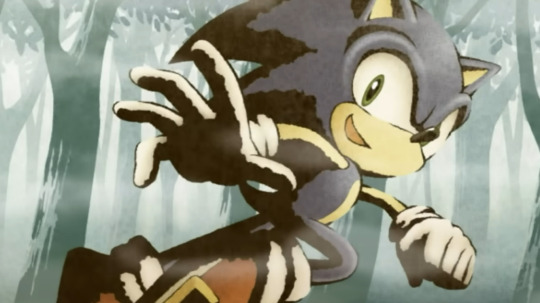
I want to address a common sentiment in the fandom that I've seen countless times over the years - the idea that Sonic should be more humanlike. Specifically, the idea that Sonic should have more human traits, such as anxiety or insecurities, that make him emotionally vulnerable in some way.
I have always felt that this sentiment strips away what I love about Sonic so much—that it goes against his character as someone who is meant to be inspirational rather than relatable. From the bottom of my heart, I truly believe that making Sonic more relatable ruins his appeal and misses the entire point of what role he is meant to fulfill. Sonic being the way he is, an inhuman being that is extremely strong and unyielding mentally and emotionally, makes him an inspirational character that is appealing outside of the realm of relatability.
Please note that I am discussing Game Sonic for this essay, not any versions of Sonic from spinoff media.
(Special thanks to @blurredblu for helping me write this essay!)
Relatability =/= likeability
First, it is important to define "relatability" for the rest of the essay, as what is seen as relatable can vary across countless different cultures and lifestyles.
In this case, we are discussing facets of the human psyche. Traits such as emotional vulnerability, insecurity, or trauma are traits seen as humanlike because they imitate the depth of the human mind. They come across more realistic, and thus relatable to people in real life who have generally gone through emotional hardships.
Relatability is also considered with the implied audience in mind, according to Craft in the Real World by Matthew Salesses.
If relatability were somehow a goal of craft, then the question should be: How can a writer go about trying to make a piece of fiction relatable? If we mean “relatable” as sharing a reader’s experience, the first place to go is audience. We must always ask: Relatable to whom? Which brings us back to the elephant in the room—to call a manuscript “relatable” is really to make a claim about who the audience is or should be.
When writing relatability in fiction, what is important to recognize is who the target audience is. Sonic is a character that was initially created to appeal to a wide target audience, not only meant for young boys but for girls, women, and an older age range in general. When it comes to marketability however, Sonic is almost always advertised towards children, and this demographic is the most pertinent when we look at versions of Sonic written with relatability as a goal. With this idea of the target audience in mind, a character who is portrayed as young and having a childish temperament would be more relatable. The Paramount Sonic movies are a great example of a version of Sonic explicitly written to be relatable to the target demographic on a broad level, heavily influenced by the culture that the movies derive from: specifically a middle-class, suburban, small-town vision of American life. Sonic is portrayed as dependent, inexperienced, and abiding by a nuclear family structure who idolises many elements of American popular culture, such as Keanu Reeves or Marvel/DC superhero comics. Compare this to the games, where Sonic is shown to be self-supporting, wise, and living life as an unfettered vagabond, all without a trace of any pop culture utterances.
In other words, Sonic was created to be the height of unrelatability to his target audience.
It is not lost on me that the prevalent desire for Sonic to behave realistically ties into the idea that the goal of crafting a good character is to emulate realistic human characteristics. A character's relatability is what allows audiences to connect with the character, which is considered unequivocally a good thing.
What is forgotten in this rudimentary line of thinking is that characters in media need to fulfill a role. Characters are not people like you or me, but fictional creations made to serve a particular purpose. There needs to be thought put into what narrative role the character fulfills and why they are portrayed a certain way to the audience. Hence, there must be a reason for the relatability, instead of employing it haphazardly.
To quote Craft in the Real World once more:
"readers’ expectations for fiction are created by their previous experiences with fiction—in other words, by culture."
The desire for Sonic to be relatable can be attributed to people recognizing pervasive tropes present in their previous experiences with fiction, internalizing these commonalities as the correct way to write good stories, and assigning these to Sonic as a result. While I can understand the logic behind this thinking, it is crucial we don't limit our appraisal of media by saying a protagonist ought to abide by a certain limitation, when it's the breaking of rules, however rigid they are, that allow for different methods of storytelling. Sonic breaks the so-called rule that a protagonist must be relatable, and it's this unrelatability that enhances and strengthens the narrative in many Sonic games. In other words, writing Sonic in a relatable way can be a way to write him; that does not mean it is the only or correct way to do so.
We should bear in mind that there are usually financial incentives to cast characters as mentally or emotionally relatable to audiences. To create a protagonist that appeals to all audiences to maximize revenue, the solution is typically to make them broadly relatable. While this can be a successful formula, it is important to not apply it to media indiscriminately. If a myriad of works all prioritise having characters be relatable over what makes them unique, you may end up sacrificing creative integrity for the sake of following a trend. In Sonic's case, you would lose the inimitable appeal that makes him stand out. While relatability can be valuable in certain contexts, it should not dominate all other considerations of writing a character, especially when it is done for the purposes of profitability as opposed to earnestly conveying a character to, ultimately, tell a story.
What makes Sonic stand out
What, then, makes Sonic stand out as a character? His inhuman mental fortitude. In a wide and varied cast of characters such as the Sonic cast, each with their own unique emotional struggles, Sonic stands out as the sole character with no struggle. He has no weak point, no Achilles' heel. Though he is weak to water, that is only a physical weakness. Mentally, he is too strong for anything to affect him long-term.
As stated before, characters are designed to serve specific creative purposes. In Sonic's case, his striking mental resilience is to highlight other messages and characters in the story. This is because Sonic usually plays the guiding or support role in his stories. He is not the sole focus. There is always at least a second character that the story focuses on to highlight that character's problems and struggles, and how that character ends up overcoming that conflict, often with Sonic's help.
With all this in mind, would Sonic stories be improved if Sonic was, instead, a human-like character with flaws and insecurities? Or would this muddy his core concept and require all Sonic stories to be changed unrecognizably to fit this new, different character?
Sonic has no backstory - and that's a good thing
Understand that this section is not an attack on backstories in general. For the most part, backstories provide insight into a character's motivations and personality. They are effective in accomplishing what they were meant to do - creating characters that are meant to be realistic.
Sonic is not meant to be realistic.
Yuji Naka once stated the reason behind Sonic's lack of a backstory in an interview: if you uncover all the mysteries, then the character will become uninteresting.
Very little information of Sonic's backstory has been revealed. We know that he is from Christmas Island (same interview link as above) and it is implied in the Sonic 1 manual that he and Eggman already know each other and have been regularly tussling before the events of the first game. These are vague and unspecific details that are not brought up in Sonic games at all, and for good reason.
Distance is required to portray a character who you are meant to be separate from rather than analogous to. Maintaining a certain level of mystery around Sonic creates intrigue, as a question is begged but never answered or even brought up in Sonic stories. This is because Sonic's backstory has no relevance on the narrative and delving into it is not necessary.
Sonic's motivations are simple and straightforward. He likes to run and go on adventures because it's fun. He likes to help people not out of some heroic obligation but because he wants to do what he feels is right. There is no need for a backstory to explain Sonic's motivations when they are plainly presented to you in such an uncomplicated manner, and what's on the face of it is just wholly what it is.
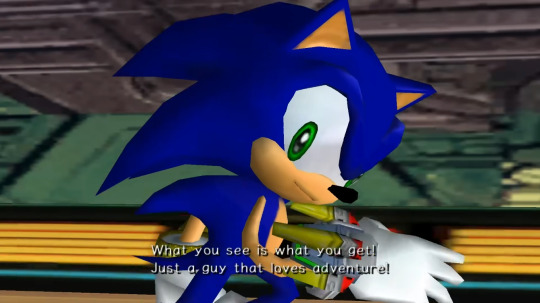
Sonic is also a character that remains static rather than having a major character arc. While he can grow when it comes to things that don't affect his overall character, such as Sonic learning and overcoming Shadow's Chaos Control technique in Sonic Adventure 2, his personality always remains the same. He has been a fully realized character since the beginning of the franchise.
Compare this to a character like Tails, whose character arc is about him being bullied for his two tails in the past and being inspired by Sonic to be more confident in himself, as communicated in the Sonic 2 manual and his Sonic Adventure campaign. Divulging Tails' backstory is necessary for the improvement of Tails' circumstances and confidence levels to be effectively communicated in the story.
Fictional characters are narrative devices created to tell a story. They are not real. Again, there must be narrative reasons for them to be the way they are.
Providing Sonic's backstory would serve no narrative purpose—none that would serve the themes his stories and character are meant to serve, at any rate.
Sonic has no trauma - and that's a good thing
Upon analyzing Sonic's character in the games for so long, it has become astoundingly clear to me that Sonic does not have an ounce of mental trauma from everything he has been through. This should not be seen as a bad thing, but rather a well-thought-out and deliberate decision that serves to reinforce the role his character serves.
In the face of situations that would be considered stressful or traumatic to the average person, Sonic remains unfazed and even excited. There are countless examples of this: Sonic jumping from a plane with nothing but shrapnel to use as a surfboard in Sonic Adventure 2; Sonic expressing excitement that he's near an active volcano spewing lava in '06; Sonic exuberantly grinding over pits of lava in Black Knight; Sonic burning up with excitement at the prospect of dangerous stakes in Team Sonic Racing while everyone else seems to be concerned.
For Sonic, danger and near-death experiences are not a source of emotional struggle, but rather a source of fulfilment and joy. He lives life on the edge; the excitement of diving off of a plane or nearly falling into lava only fuels his love for life.
Additionally, Sonic also enjoys the simpler pleasures of life. Exploring the world. Reading books. Going on relaxing vacations. Racing through open fields. Life is one big adventure and Sonic is having a blast living it.
The idea of Sonic having some kind of secret, hidden trauma that he hides under the guise of a fake smile can be a fun fanon trope, but, for the purposes of canon and official Sonic stories, there are clear reasons why they should stay as fanon. If Sonic had trauma, it would undermine his unrelatability and make no sense given his role in his stories. Tropes such as Hurt/Comfort and Angst are ubiquitous when it comes to fandom culture, and this could be a case of those tropes appearing in the Sonic fandom simply due to the nature of fandom itself. Enjoying fanon in and of itself is all well and good, but advocating for it in canon will homogenize it by stripping away what is unique about the media we love.
In the end, there is no reason to believe that Sonic pretends or does not behave genuinely when it comes to expressing his true emotions. Sonic simply has nothing dark inside of his heart to hide. This is confirmed in Unleashed, where Sonic's heart is strong enough to resist the negative emotional forces of Dark Gaia without him even realizing. The subconscious nature of the action combined with his humility even leads him to initially think it to be Chip's doing. His heart is so strong and so pure that it is incorruptible by negative forces. This shows how Sonic's resolve is effortless and practically baked into who he is.
Sonic's internal strength is completely unconscious on Sonic's part. He doesn't actively try to be the way he is. He just is.
Sonic doesn't cry - you get the idea
It has become a hot topic in the fanbase in recent years that Sega once provided a revision note for Sonic to not express excessive emotion such as outwardly crying or sobbing.
This idea has generally been met with hostility and aversion from fans. However, this negative reaction has always confused me, and I hope to offer a different perspective to the issue.
Why does Sonic need to cry?
Let's expand on this argument for fairness' sake. A common rebuttal grants that Sonic doesn't usually cry. But in extremely emotionally difficult situations, such as loss or mourning, Sonic should cry because it is only natural to cry in such a situation.
Again, I want to challenge this notion. We could approach it from the angle of human psychology and behaviour—it is far from the case that everyone cries in response to severe adversity, belatedly or otherwise—but instead I want to explore this with respect to the narrative angle we have covered so far. Specifically, with respect to the idea that characters, unlike you or me, are designed and portrayed with certain purposes in mind.
Why would it be natural for Sonic to cry?
To help understand Sonic's handling of loss, let's analyze four examples from the series of Sonic losing someone.
In Sonic Adventure 2, Sonic stays strong and composed right after Shadow's presumed death, paying respect to his fallen ally.
In Sonic Unleashed, after Chip leaves him, Sonic takes a deep breath before moving forward with a smile on his face.
In Sonic Battle, Sonic is desperate for Emerl to live and expresses this openly.
In Sonic '06, Sonic expresses a great amount of despair when Elise dies in an explosion aboard the Egg Carrier.
It is clear from the outset that Sonic is not an uncaring individual - he wouldn't do all the selfless things he does if not because he didn't care about people. He also still feels strong emotion at losing those close to him, but he handles those emotions with a great deal of fortitude. In Adventure 2 and Unleashed, his reaction is more subdued, while in Battle and '06, it's clear that Sonic is upset and isn't afraid to show it. The difference could be due to that in the prior examples, Sonic watched them die in front of his eyes, while in the latter examples, they were already gone by the time we see Sonic's reaction.
Nevertheless, Sonic feels emotion. It is only because he does not express himself in an adequately typical way that this idea is met with so much outrage and pushback. Because Sonic does not cry, and because an expected response in certain scenarios would be to cry, it is perceived as a writing mistake that must be fixed. Sonic is perceived as a bad character because he does not fit into a rigid box of socially acceptable expressiveness.
But why is Sonic acting outside the norm necessarily a bad thing? The fact that Sonic can go through such hard situations and remain positive is a testament to his strength. The fact he doesn't cry makes him come across as superhuman when it comes to mental fortitude. That is not a mistake of his character that needs "fixing." That is the entire point.
The animosity towards the idea of Sonic not crying, that he must express himself a specific way, a distinctly normal and humanlike way, is stirred from the irrational, yet sadly common, leap in logic that Sonic must behave and experience life like you or me.
There is an irony, too, to how localised this demand of realism is of Sonic. I've seen no outrage demanding that he spill blood or break bones like us. But, apparently, he must shed tears to be a good character. Sonic is superhumanly resilient while running, or fighting, or taking on the miraculous powers of the Chaos Emeralds. Chaos is power and power is enriched by the heart. Sonic's is shown to be one of the strongest and purest out there, one that moves ever on from and through the pain of loss, grief, and tragedy. Isn't it bizarre, then, that this is considered a defect to him?
The messaging of Sonic
Sonic's core concept as an inspirational character must be maintained because it is key to the emotional messaging of nearly every single Sonic game.
Right from the very first game, you play as a plucky little hedgehog, fighting against the tyranny of Eggman's industrialization threatening to destroy all life on the planet.
Sonic is small and unassuming. But he fights anyways, determined to stop Eggman. And he does.
This concept remains throughout the franchise. Sonic always remains steadfast in the face of great adversity. From Sonic CD's "You Can Do Anything" vocal theme telling the player to believe in themselves to simple yet motivational phrases—ones that Sonic himself has given to the likes of more normal characters such as Elise: "If you have time to worry, then run!"
There is even a quote on the Japanese box art of Sonic & Knuckles comparing Sonic to the Sun, the far and unreachable star in space that our entire galaxy revolves around.

We look up at the Sun like how we look up to Sonic.
As brought up earlier, Sonic is the antithesis of relatability to his target audience, children.
This is because he is meant to inspire children.
The fact that Sonic remains so popular and successful to this day is undeniable proof that relatability is far from a necessary ingredient for likeable characters. Given the fact that Sonic is such a strong-willed character, that he fights endlessly against adversity with a smile on his face, that he always gives positive words of encouragement, is it any wonder why he is so popular with children? Sonic is a wonderful role model that promotes living life to the fullest. Sonic is deceptively wise, seeming to know simple yet effective solutions to every problem. Sonic encourages you to chase your dreams, to stay strong through hard times, to enjoy life.
Sonic is a friend who is always there for you.
Not only does Sonic provide guidance to characters, he provides guidance in the real world as we navigate our lives and the trials and tribulations that come with them. Each character that presents a problem is the character we are meant to connect with, and Sonic is who we strive to be.
CONCLUSION
I do not hold any grudge against relatable characters. I love them, just as I love all kinds of different characters in all kinds of media.
I believe that coexistence is possible. I believe that you can praise a character for their relatability and realism, just as you can praise a character for being the antithesis of both of those things, and these do not have to be contradicting principles for one to have. It all depends on a character's narrative function and how their character traits – both relatable and unrelatable – serve the story that is being told.
Sonic the Hedgehog is a character whose role in the narrative is to inspire and guide other characters. From a Doylist perspective, he represents the prominent, all-embracing messaging about staying strong and positive despite all odds, inspiring and guiding his target audience.
Every decision put into Sonic's character traits serve his role perfectly. Of course this extraordinary character does not behave like you or I do. Why would he? That's simply not his nature; a gust of wind in the breeze, moving endlessly all throughout the world. A pure and positive heart who has achieved the innate desire of all humankind in a way that we will never truly understand, free from the burdens of human nature. Freedom.
Sonic is unrelatable and unrealistic. And he is an amazing character.
#sonic the hedgehog#sonic#essay#sonic characterization#sonic fandom#long post#sonic analysis#my first time writing and posting an essay online about sonic!#i've come to realize that people may actually be interested in what i have to say#and i am very passionate about sonic so this was a great exercise for me
341 notes
·
View notes
Text


'The Tigger Movie' is a representation of the sad clown paradox and examination of the ways lack of social support makes depression worse. Or, in more colloquial terms, 'The Tigger Movie' is a story of when the happy friend in the friend group gets depressed and no one knows what to do about it so they just make it worse.
The sad clown paradox refers to the phenomenon when a person who serves the social role as entertainer, or at least the person who makes everyone else feel better, is themself depressed and with no one to comfort them. Tigger serves this social function within the hundred acre wood even if he doesn't necessarily receive a lot of thanks for it, often dismissed as a nuisance or a problem. One of the strengths of 'The Tigger Movie' is showing how Tigger's absence is felt, in one scene all of the other residents all go around explaining to Rabbit how helpful and supportive Tigger is.
The tragedy of the film, and arguably the conflict that sets the plot into motion, is that they often forget to tell Tigger. Which leads Tigger to feel lonely and socially isolated.
Tigger's depression is represented within Disney's 'Winnie The Pooh' franchise often. We seem him struggle with self confidence in 'Pooh's Grand Adventure' but only admits it to the others in the third act. We see him struggle with self image in 'Stripes', an episode of 'The Many Adventures of Winnie The Pooh', when his stripes wash off and the other are convinced he's no longer Tigger. This is why the best Winnie the Pooh installments we see Tigger have a subtle bond with Eeyore who is the only person in the hundred acre wood who seems to recognize how sad Tigger can be. But as these and other examples illustrate the other denizens are often uncomfortable with how to respond and be supportive to Tigger during his depression spells, since they take his comfort for granted.
Never is Tigger's depression as bad as it is in 'The Tigger Movie' however. Tigger starts the movie a little melancholic and lonely but it's the reactions of everyone else, too busy with their own problems to notice their friends trying in his own way to ask for help, that tips things over into full blown depressive episode. The normally bouncy Tigger can only melancholically ruminate on his own loneliness, exacerbated by his friends emphasizing how they are not Tiggers as explanation for why they are not interested in hanging out.
Roo's roll in this is fascinating because, while he does mean well, he only manages to come up with bandaid solutions to the problem and only manages to make things worse every time he tries to help.
Roo suggests Tigger should find his family of other Tiggers, Tigger obsesses about this idea with great enthusiasm at first but starts to slide back when the search yields nothing.
Roo suggests Tigger write his family a letter, Tigger is once again hopeful but when again returns to his depression when he doesn't get an answer.
Roo convinces the other members of the Hundred Acre Wood (sans Rabbit) to forge a letter from Tigger's family. Once again Tigger is ecstatic but he misinterprets the letter as saying the Tiggers are visiting him soon.
Roo convinces the others to dress as Tiggers and visit Tigger, but when Roo blows their cover Tigger becomes convinced his friends have escalated their previous callous behavior to full out mockery and leaves them to go out into a blizzard to find the family of Tiggers he not only believes exist but will give him some sense of community.
None of this to say that Roo is the secret antagonist of the film or anything that melodramatic. If he had other older people to bounce his ideas off things probably could have stopped before escalating. But since everyone else is caught up in their own problems they don't really give this issue the attention it deserves and so Roo is left stumbling around.
The only person who has not gone a long with all these misfires is Rabbit, the most level headed one who's need for order and control often put him at odds with Tigger. In the films climax Roo's last attempt to fix everything is to rally everyone to go out into the blizzard, find Tigger and bring him home. Pooh has the idea to bring Rabbit into it to help them. Now finally invested in helping Tigger his friends all work together to remind Rabbit of all that Tigger does to help them all ("sort of lights up the room when he enters" as Eeyore says), thus convincing Rabbit to help them.
The finale feels like an intervention, the Hundred Acre Wood residents journey into the blizzard to rescue Tigger thus confronting him with how much they care for him. This gives him enough of a boost to turn around and help them by saving them from an avalanche (In typical blockbuster finale fashion where a visual spectacle set piece is paired with the climax of an internal emotional conflict). Furthermore, when all the thrills of the climax subside, Tigger is further confronted by the proof that his friends all wrote the letter and he accepts them as his actual family and that he doesn't need a literal family of Tiggers to make him feel less lonely.
What's especially interesting about the consequences of this finale is that Tigger's recovery has a ripple effect through all the others. Once his mental state is more balanced Tigger goes around and helps everyone else with the micro conflicts they had had throughout the film that kept them too distracted to help him. Reaffirming all the things the other said about him to Rabbit about his roll as comfort and support within the larger social group.
109 notes
·
View notes
Text
Equally Invalid
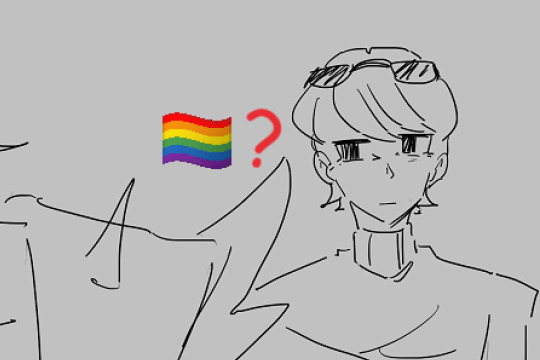
#trafficshipping#smallidarity#<- shipping rlly isn't the main main focus here but it ends on the kiss so I'm scared to tag anything else lol#cw blood#my art#animatic#it's more like. visuals for character analysis thoughts. because this is way more fun for all of us than writing it all out as an essay#I don't expect you guys to. Get it btw or at least not all of it alot of this is very self indulgent and jumps around the timeline#it's like 99% just for me but still. I hope the smallidarity enjoyers of the world can get smth out of it at least lol#very very very happy for ppl to ask abt specific scenes if ur interested ofc#I prefer not to spell out what things mean cus like. It's more fun for me thinking of ppl applying their own thoughts onto my stuff.#but if you ask I will yap forever god bless#if you want you can play a game of spot the jojo reference. and spot the utena reference#ANYWAY YEAH WOO scott and joel content yes yes yes woo!!!!#do they have a duo name like. at all. is that a thing#happy pride everyone
422 notes
·
View notes
Text
I'm once again getting overly philosophical over horror movies, so here's a study of the death angels from A Quiet Place as observed by a very enthusiastic animal loving veterinarian.
Every time people talk about death angels, it is, understandably, about how violent they are. These creatures are brutal and merciless, and will tear apart anything that makes too much noise. Hence the title of the movie.

Death angels are frankly terrifying, and show no empathy towards the creatures of the planet they invaded. No living thing is safe from them.
... so here's why they COULD be--
Look. Death angels are simply not suited for our planet. It's a noisy, chaotic place full of noisy, chaotic animals. From humans, to raccoons, to birds, to cats, nearly everything in our world is a potential trigger for a noise sensitive animal such as these.
But that's exactly what they are. Animals. And no one seems to remember that fact. People talk about them as though they themselves are sentient, anthropomorphic monsters, but the way these creatures act mimic many real life animals. Animals that don't belong here, but are trying to survive here. On a noisy planet covered in water, which they despise and cannot swim in.
Death angels are completely blind by nature, as seen in many other creatures such as cavefish, moles, and my personal favourite, the olm. Due to a lack of sight, they very clearly use echolocation in the film, to scan their surroundings and... well, not get dead. But echolocation is far from their only tool, as their ears are the strongest asset they have.
Their ears are INCREDIBLY sensitive. Just the slight ticking of an egg timer when heard from their perspective in the first film, is like a pounding drum in their ear. This is fine in a naturally quiet planet, but if a very subtle tick is that loud, then imagine the rest of the noise. Screaming. Explosions. Crashing. Little toy planes. Holy CRAP, that's gotta hurt.
Sounds that loud would definitely cause extreme hearing problems from pressure over time, and easily result in lifelong illnesses and disabilities such as deafness, infection, and so forth, if not stopped. It's going to be painful. It's literally bursting their ear drums inside their heads, and you can't explain to an animal why it hurts. You cannot rationalise with wildlife about treatment and self care. An injured and scared animal is always going to turn hostile, no matter how docile they may be normally. You can't explain to a lion with a knife in it's belly that you can stop the pain if it just doesn't attack you. You can't explain to a death angel that it needs to go somewhere more isolated instead of just destroying the source of the noise to shut it up.

Going to backtrack here a sec. Remember how I mentioned echolocation being another asset this creature has? Which means the slightest movement, the tiniest breath, can immediately allow you to be seen by it. With ears that good, too? It can see you from ages away. It knows you're there. Which means they DON'T attack for sport.
'Evil' is a concept rarely seen in nature. Yes, a lot of humans can be evil. And yes, many creatures can be too. Animals hunt for sport as well. Cats, for example! Although even then, I wouldn't describe it as evil. Calling the death angels evil implies they're attacking out of malicious intent, which just isn't true. In moments of panic, they'll destroy. But they are fully aware of humans around them.
Humans need to breathe, and can't stay perfectly still very easily. The death angels would be able to see our main cast at several points, even when they're being quiet. They don't attack whenever they locate a sign of life. For example, the scene in the basement. Being that close, whether the water was running or not, that alien absolutely would've heard Evelyn and the baby's sharp breaths. It didn't care. It was clicking at them almost curiously before it heard the bang of the silo, to which it ditched them to stop the sound.
This scene is a great example of why they don't kill for sport. Injured and young animals are especially easy prey for a creature built so strong and nimble. Evelyn is shown to be terrified of the mere presence of this thing, but it never actually does anything in the scene. It moves about. Ignores her movements in the flooding water. Investigates the baby. Clicks curiously at her while she backs away. It moves slowly and on all fours, when we know while aggressive, they will stand up on their hind legs (unless sprinting) and move very fast.
This implies it was in... well, not a submissive position, but a nonthreatening one. It wasn't baring it's teeth (as best it could), it had it's claws tucked up and unused, and was in no way in a primed-to-attack mentality. Until the silo made a loud bang. And even then, it could've quickly sliced up the two in the basement before running off, but it DIDN'T. It just left, without a moment of hesitation.
Let's also acknowledge the anatomy.
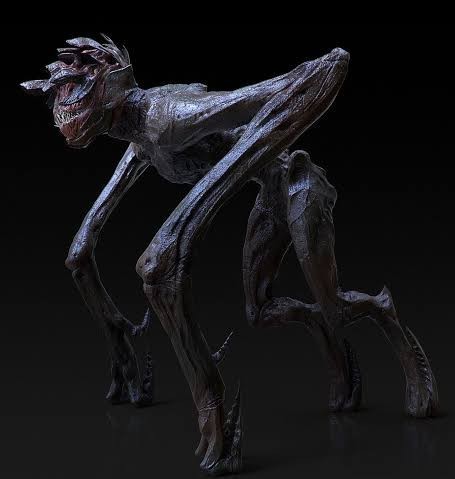
This is a carnivore. With sharp teeth for ripping apart prey, sharp claws for defence, and thick armour for protection from it's natural climate, as well as strong, long legs for running, this is absolutely a meat eater. The fact it's so well equipped makes me wonder if their natural prey is just as dangerous as them, which is why they have such tough skin. Or if they themselves have something above them in the food chain.
They seem to be pack animals, as usually others aren't far behind when one is about. Such as the trio by the Abbott house, the few at the docks, the ones by Emet's hideout, and even that group sliding down the building in the Day One clip I keep seeing as a gif. With their knack for running included, I wonder if they function like lions? Blending into their environment back home, clicking to hear prey, then the whole pack going on the chase when their target is vulnerable, in a way.
I got distracted. My point was, in a year, all the bodies from past victims vanished. All those people in the town who were swiped left and right just vanished from the town. They couldn't have decomposed in such short time, which means something moved them when it was safe. Something like a carnivore needing food after it felt comfortable in the silent aftermath. The argument that they do it for sport is one I see all the time, and it's just not true.
Everything needs to eat. Carnivores need to eat. Animals need to protect themselves from suspected danger. They never eat on screen because whenever they're on screen, they're surrounded by noise and are DISTRESSED. Have you ever had a sick pet? Most of the time, it won't eat when it's ill because it's too stressed, uncomfortable or in too much pain. When having their ear drums assaulted, a death angel isn't going to sit down with a cup of tea and a grilled cheese. Also, I won't add it because there's blood, but in the scene with the old man screaming in the woods, after it attacks, you can actually see it go back on all fours and sniff about the aftermath, like a hungry predator catching prey to eat. This was probably the first and currently only on screen proof of my claim.
By all means, not all animals are meant to be tamed. Jordan Peele's Nope said that best. Yet I can't help but wonder about the individual. Every animal is completely unique. Some will tolerate more than others. Due to their realistic nature and the similarities to actual animals, in specific circumstances, could they be befriended?
Anyway keep an eye out for A Quiet Place 4 where someone has a pet one that wears doggy ear protectors and accepts meat in exchange for pets-- /j
#this is a very roundabout way of saying I want to pet the lizard cats#they can purr they are CATS#.../hj#anyway I do genuinely find them very interesting to study as if they were real creatures#I hope we get more insight into them in Day One#especially considering it adds Frodo to the mix#so we'd already be studying one species' adaption to their being on earth#the opportunity to compare natures is RIGHT THERE#I'm hoping 🤞#a quiet place#a quiet place part ii#a quiet place day one#death angel#death angels#long post#zoology#I guess#maybe#let me have this I'm an animal nerd AND a horror nerd#tw gif warning#tw horror#analysis
474 notes
·
View notes
Text
something I feel like people miss while reading stormbringer is this line from the second chapter when Dazai and Verlaine met:
'Nevertheless, Dazai continued to slaughter his enemies and serve the Port Mafia in order to force himself into an even darker place.'
So, "why does Dazai stay in the mafia for so long?"
Because he wants to be in a bad place. He wants to commit these atrocities to further dehumanise himself. He wants to alienate himself and is determined to convince both himself and everyone around him that he is a terrible thing, the 'black wraith of the Port Mafia' who had no empathy or sense of humanity.
That's why he stays in the Mafia, that's why he works so hard in the Mafia, that's why he does what he's told. He's an automated killing machine capable of planning out and causing mass destruction, and his fuel is self-hatred.
He doesn't take pride in his 'accomplishments' in the mafia because, again, he doesn't actually want to succeed in the mafia, he wants to prove he's a bad person. He's not in the mafia to try and find a reason to live anymore, his reason for that is Chuuya, he's realised he's not going to find it in the mafia, even if he's not going to admit it until the dark era.
He probably feels a sense of guilt and disgust, but refuses to acknowledge it because he thinks that as something inhuman, he isn't meant to feel things like that, and the more he does, the further he removes himself from any sense of remorse, until he doesn't feel it any more, and probably still hasn't processed even in the ADA.
He stays in the mafia, and does the things he's told with such accuracy and deadliness because he thinks it's the only thing he can do, and he can use it to prove he's no longer human.
#appreciate the use of his ability name in the last sentence please#anyway#he's a complex character and i love him and want to kick him down the stairs in a box#he's so interesting#and stormbringer is mainly chuuya based and I'm thinking about his character a Lot#but also Dazai has some interesting moments that add to his characterisation#that meeting with verlaine is very important#done yapping now#silas yaps#ao3 fanfic#bsd#soukoku#bsd fanfic#bsd dazai#bungou stray dogs#bsd chuuya#dazai angst#dazai#dazai osamu#dazai analysis#bsd analysis
391 notes
·
View notes
Note
do you happen to have that page that talks about the beauty standards of each race?
Yeah sure. While scavenging pics for this I found this neat reddit compilation & chart & theory talk too. I had um, way more to say than I anticipated (I know you only wanted the one page. I have nothing to say for myself. Like most topics in Dunmeshi things snowball because they’re so interconnected. Mercy…) so, many races and observations are only mentioned near the bottom.
Beauty standards and race in Dungeon Meshi


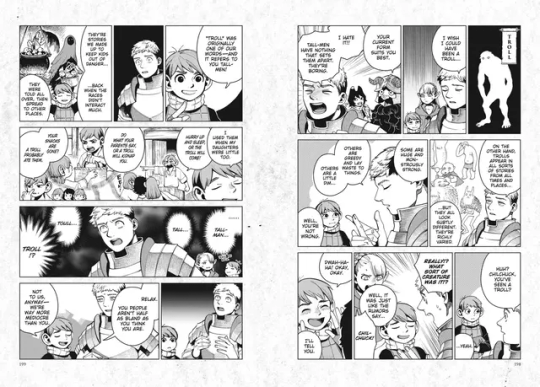



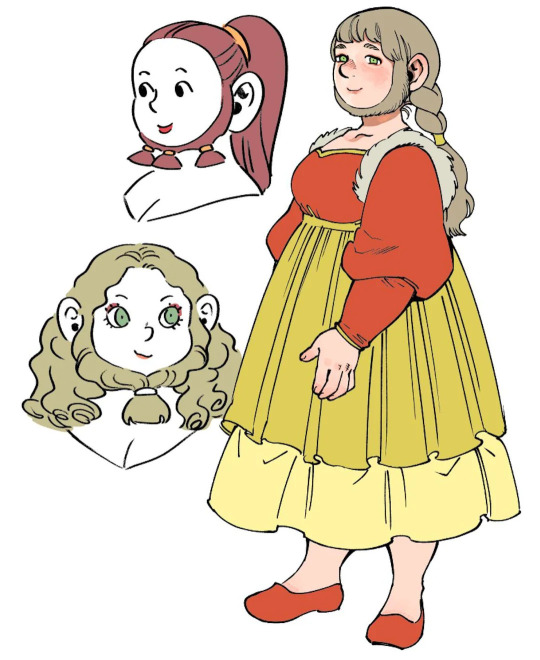

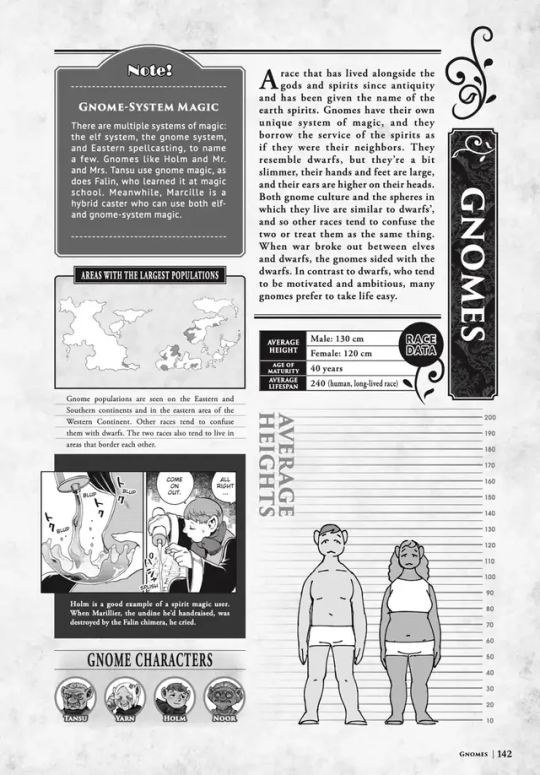

Not pictured there’s also how elven society is harsh on visibly disabled people, and how the demon took away Mithrun’s silver eyes and ears to take away his pride. There’s also how Senshi might have fit in with the orcs more easily because of the dwarven wide body shape, and how they tend to have more body hair too I suppose. In the extra on orcs we see Senshi living with the orcs and he gets judged because of the hierarchy rather than his looks.
What is fashionable also differs from culture to culture, and there’s how tattoos only seem common with elves, though dwarves and others do also sometimes have some. They seem to not raise much brows, which makes sense since for many essentially they’re for professional (magical) purposes especially with elves. Gender roles also differ in type and importance, but generally they are similar to irl ones for the races we see. Elven society seems to be the least gendered, which would be an unsurprising logical outcome of having lesser sexual dimorphism aka they look more androgynous. Comparing fashions and gender roles and how they affect beauty standards would be a whole other compilation and conversation. Kui has great worldbuilding partially because she’s got such a good grasp on sociopolitics and geopolitics. History affects cultures and beauty standards greatly. Kui’s oneshot Distant Utopia was very eye opening on her way to worldbuild and the consideration she gives these things, I do really recommend reading it.
Out of the big 5, we know the least about gnomes, but their sheet does say both culture and region are similar to dwarves’ and they end up being confused together often, so we can imagine the beauty standards are similar to dwarves’ as well.
I wanted to touch on this in a post eventually, but how one daydream hour page said half-foots tended to be curvaceous like in the artwork below puzzled me for a long time, all the half-foot characters we see during canon are rather slender and lanky after all, Chil’s succubi also being more curvy than plump. Economics are for sure a factor in that I imagine, the half-foots characters we see are all implied to be some flavor of poor or malnourished, as are half-foots depicted as empoverished oppressed minorities in general. Even comparing the artwork with the half-foot sheet’s depicted average half-foot, the ones on the left seem bigger. Wouldn’t it make sense though, if unlike dwarves half-foots don’t have similar naturally wide bodies, yet due to idolizing dwarves they work towards having a similar body shape/type to emulate them?


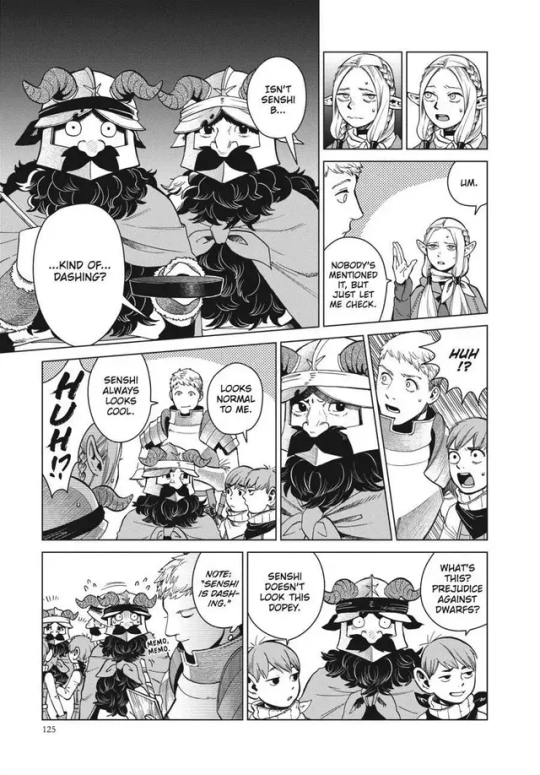
It’s said half-foots tend to stick to pretty ethnically homogeneous regions (aka half-foots-only communities) unless they move to the big city with ambition to try and make it big (like Chilchuck and his wife & kids did), and that’s interesting imo because then that would mean that in a ton of half-foot communities, they rarely see or interact with dwarves whom they try to emulate. Of course, one thing about beauty standards is that when they get adopted, at one point it stops being "this is how dwarves look and so this is how half-foots should look" and just becomes "this is how half-foots should look", most people feel as though beauty standards aren’t learned but innate, so I figure the half-foots wouldn’t have any problem still seeking dwarvish traits when there are no dwarves around.
There’s also stuff you can glean here and there if you want to extrapolate more. Like how in the race swap artworks, Mickbell is only smiling in the dwarf portrait, and Rin’s elven portrait looks very close to her elven one- Rin who is stated to be beautiful in her profile blurb. Benichidori’s extra does teach us tallmen can definitely have harsh beauty standards, but also since the text portrays her as very dysmorphic that’s likely reflected in her thoughts to a much more intense degree than is common, not an accurate strict baseline to go off. Ah, Kabru’s blue eyes are also why he and his mother lived a rough life in Kabru’s hometown, but that seems to be regional. Good post here on the topic of Kabru’s blue eyes and ties to irl history. There’s a lot to be said about Kabru being a man that in many ways is close to elven beauty standards, and how that might have affected or been affected by his upbringing with elves + his persona as someone that can effortlessly charm most people. Marcille’s section here in this essay also goes into Marcille’s struggles to fit in with the ideal image of an elf.


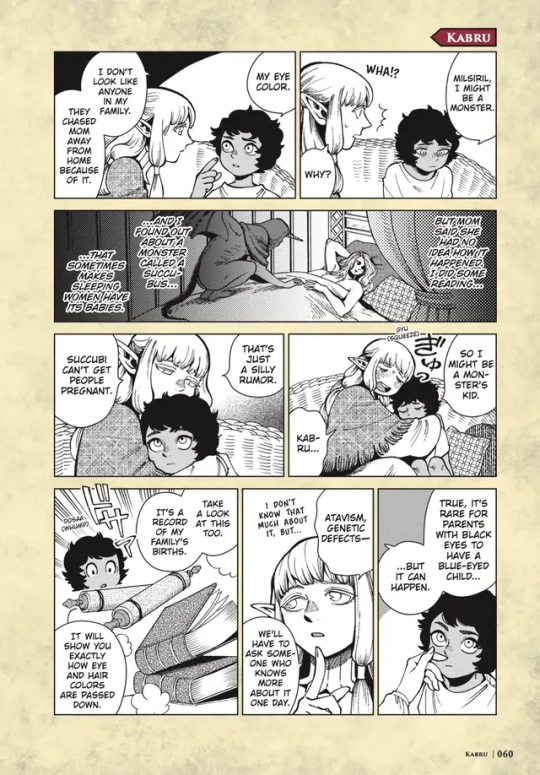
Looking human
Also notable are beastkins and demihumans: Demihumans are all dehumanized which makes people treat them worse. So if you differ from the visual idea of "human" (an in-world subjective categorization just as much as demihuman is) most people do judge you negatively. Elves and dwarves get to fight about which type of human is considered the prettiest, but demihumans are below tallmen and half-foots, they are considered as simply below the beauty contest, incompatible with it.
Onis are perhaps the demihuman people we know of with the least cultural influence on the dunmeshi world, and with the least intensely different appearance than other demihumans—they seem to be technically categorized as human to people not from the eastern archipelago?— but even them are treated as lesser than human, treated as beasts to slain for reputation points or useful strength to have around and command. It’s said their "magnificient horns" and fangs are often shaven off when the oni lives in tallman towns, so you could easily make the argument that onis are denied the right to have their own beauty standards, having to conform to other people’s and going through mutilation to take away features they might otherwise have taken pride in. Inutade was bought by the Nakamotos from a dangerous sumo fighting ring that got one of Inutade’s tooth broken on her first and only fight, and kept as a low ranking servant ever since. Remember when I said different fashions existed in dunmeshi and how those could also affect beauty standards? Like the elves, if you look at the portraits pages which include a lot of characters that aren’t in the story you can see distinct cultures within the same races, for example one young elf is bald which is in sharp contrast with the usual elven long luscious hairstyles, and that’s especially true for onis I think. Maybe not only from different regions but different eras as well… They have a bit of population in the very north of the western continent, so I like to think some of the ogres live in very cold, maybe even subarctic or arctic conditions. The point I’m getting at here is that within a race, culture/ethnicity like with Kabru will also influence them it isn’t just tallmen as a whole, different communities will have differing beauty standards. The oni history blurb and third row first collumn portrait remind me of Mongolia (which historically was a lot of different nomadic communities with different cultural identities as well. Something something, the oni empire experienced a decline and then tallmen overpowered them, and now they’re governed and split apart by stronger social classes & slavers and the richness of culture was hurt for it especially if they have no real community left of their own), but obviously many of them are dressed and look rather japanese, makes sense considering living in/close to Wa, and first row second collumn portrait reminds me of ainus which again would be logical considering geographical placement, though I’m far from an expert. Interestingly, ainus are indigenous people both in Japan and Russia- Perhaps the northern western continent ogres are meant to be closer to Russia than Canada like I imagined? Ok tangent over.



The kobold sheet says they’re especially sought after as slaves because they’re "adorable", but locally in the western continent they’re repeatedly said to be seen more as ferocious and dangerous. The dehumanization is most apparent in the first comic below. The language barrier and conflicts no doubt worsen this by a lot, but I think it’d be hard to deny that their canine appearance makes the dehumanization worse. "They’re ferocious beasts, they’re demihumans, they can’t be communicated with". Most characters in Dungeon Meshi’s world are desensitized to slavery and most characters are prejudiced one way or another. Point being, kobolds are fully removed from human beauty standards, but no doubt for kobolds, other kobolds are more beautiful than humans are. They’re assumed to be an uncivilized bunch, but just like any other people they like to adorn themselves with nice clothes and jewelry and keep themselves clean and groomed; they too take care of their appearance and take pride in it.

And the orcs! This one we have the most contact with in canon, with not only there being foreigner characters from the ethnicity or hearsay of their homelands and culture but full on contact with a community. We get to see up close what they’re like and what they think, and of course in turn they’re our introduction to how demihumans are harshly looked down upon and seen as inferior, less human and thus less worth valuing and less dignified. It’s text that orcs are ugly to most humans and humans are ugly to most orcs. Since I judged they didn’t need accompanying explanation the pictures showing this are in the pictures dump at the top.
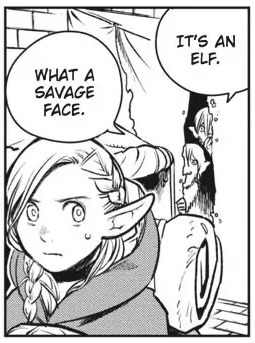
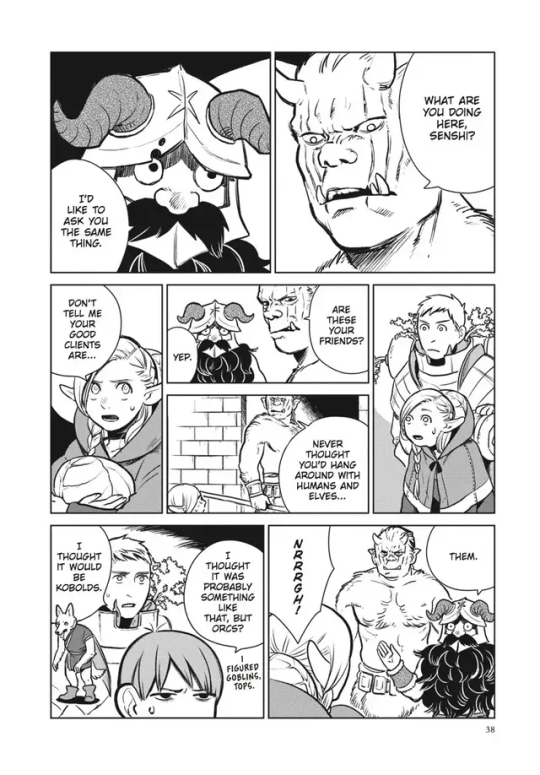

God forbid you sell vegetables to orcs my god- but then again they do basically mandate adventurers to kill any orcs they come across so yeah the world isn’t above that even a little bit.

So yes, my main point here is simply that orcs are yet another evidence of the physical ideal of "human" being an important beauty standard for human societies globally.
Izutsumi is our glimpse at how beastkins are treated in the world, and in Wa at least that’s ending up being caged and mistreated as part of a freak show. Izutsumi hates her appearance and wishes she could leave the feline part of herself behind to only be human. Interestingly, not that we have a lot of info on them so this is very much a take with a grain of salt situation, but there seems to be less stigma around artificial beastmen, those who can shapeshift at will. The main difference is of course appearance, that most of the time they simply look like average tattooed humans. Artificially creating humans is an illegal practice, and no doubt it’s not well regarded, but being able to hide that makes them less likely to be discriminated at any moment, or even just discriminated less intensely. Again, looking human is important, not only for belonging but for safety’s sake. Beauty standards rule the world with harsh hands.
Mermaids and fishmen
Ok we’re done now right? Right-! But wait… Wait…! Mermaids and fishmen are said to be demihumans too, special separate cases to the main three demihuman species however, which is also represented by how mermaids and fishmen both are in the Adventurer’s Bible chapter Monsters meanwhile ogres, kobolds and orcs are in the chapter World. They’re an interesting topic because they directly tackle this topic, not only in a meta way for the readers but also making characters themselves struggle to quantify their humanity with the goal of knowing wether they should be eaten or not, especially Chilchuck. Chilchuck’s "is it really just a matter of feelings?" mini arc.
The party asking themselves "Should we eat this?" is very common, and often they end up playing a little loose on morality, like eating the red dragon’s meat despite it having digested Falin. Not unsimilarly Marcille freaks out a little over the vegetables they harvested having been grown with fertilizer, aka largely human poo. Half of the motivation of "should we eat this perhaps sentient creature" is out of consideration and compassion, but more strongly and more often, the characters struggle with a sense of taboo at eating something too closely related to humans. Even, feel uncomfortable because of the deepseated impression that eating it would dirty them in some way. Cannibalism is an interesting and relevant topic in many ways, but what I want to mention is how there’s the more or less universal belief that committing cannibalism inherently taints you as a person and turns you more monstrous, morally but also literally depending on some myths such as w*ndigos and onis in some cases, like in Touge Oni. Marcille and Izutsumi both express a fear of eating monsters turning them monstrous. Maybe this is part of what Laios was hoping for, honestly. There are two fears here, if eating a demihuman monster constitutes as cannibalism or not, and so, will eating it taint you because it’s a human, or will eating it taint you because it’s a monster? You are what you eat, until it’s a little too literal. You morally are the means by which you get your food, and you physically are the result of your nutrition. Dungeon meshi manages to mix an exploration of humanity with the theme of food because our relationship to food is very deep and complex, psychological as much as physiological.

In the end, the characters sort of shrug and accept that they’ll never quite understand the world of mermaids and fishmen and how they operate, and what that means about them. Laios is the one always challenging these notions other characters take for granted, it’s not obvious to Laios why people are softer on mammals than other animals and plants, it’s not obvious to Laios why people would be afraid of eating a monster just because it’s a monster, it’s not obvious to Laios why some food is gross to Marcille but not fish testicles, it’s not obvious to Laios why you should immediately regard orcs and kobolds badly.
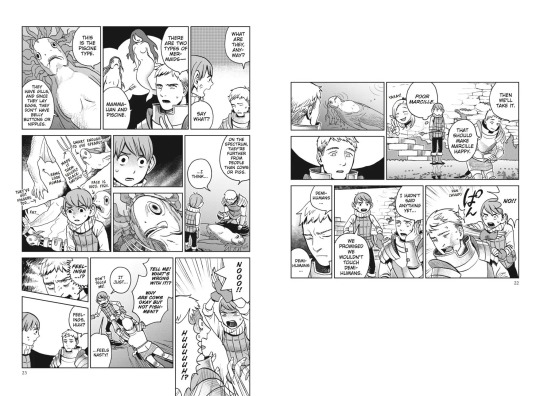
"Cows are probably closer to humans [aka closer to being human] than fishmen, though they’re clearly intelligent", dehumanization to lessen empathy towards them to be able to eat them. Meanwhile, mermaids seemingly have a less noticeable "civilization" or intelligence, they hunt in groups like fishmen, but they don’t use tools and such, they feel more primal and similarly instinct driven, and yet… Do they attract sympathy more? Mammals, humans, is it because of their nature or because of their appearance?
Both the nature and appearance of fish are ones people don’t typically sympathize with. "Fish don’t feel pain", "goldfish only have 5 seconds of memory", "it’s okay to keep fish in completely empty bowls too small for them until they die from it", so many lies and misconceptions exist that make people less considerate of them. The average lifespan of a goldfish is 10-15 years, the record is 43, but they’re not seen as lives that really matter, so a lot of goldfish die in a few weeks of bad aquarium conditions. There’s a lot of research on animals evolving to look cute and appealing to make some predators want to kill them less and parents want to care for them more, including humans. First good google research result gave me this credible short article on the topic. In Chilchuck’s weighing wether a fishman is far enough from being human or not to eat, "face is 100% fish" is his biggest argument for it being more acceptable. The face, the most important thing for empathy and recognition. The face, the decapitated fishman one that falls into his hands next chapter.
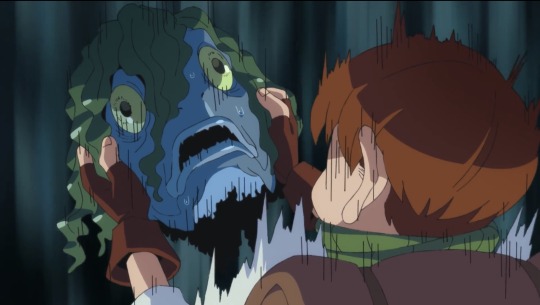

To quote @room-surprise: "Chilchuck can't explain why it's wrong to eat the merpeople, even though it's NOT complicated. But the problem is Chilchuck would have to accept and acknowledge that the merpeople might be people? And that's outside of the worldview he passively believes, so he can't just say that, because he doesn't think that's true. But that IS why he "feels" it's wrong. And it's all you'd need to say for Laios to understand! But it would require acknowledging that maybe the way they're treating and talking about the merpeople is wrong."
The idea of Chil not being able to grapple with how maybe some monsters are more humans than they seem, him who had been an advocate of half-foots rights, half-foots who get undermined and treated as inconsequential sacrifices… Grappling with how he could relate to the merpeople’s situation almost, and pulling away because it’s so existentially horrifying. I do not want to see myself into an hostile fish-faced warrior I can’t communicate with. In a way this also relates to Chilchuck being the only party member who doesn’t see Izutsumi as a cat in the relationship chart, the only one to treat her with full human dignity. He knows the struggle to be taken seriously, he knows being infantilized and he knows what it’s like to be treated as less than human.
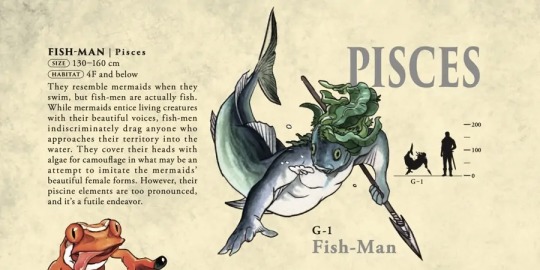
Below, you will see Chilchuck draws the line of where they become not okay to eat as when "they already look like mermaids". Above, there’s speculation that the algae hair is partly to mimic "the mermaids’ beautiful female form". Is it because mermaids are their enemies and the ambiguity might give them extra seconds to attack or flee? Is it to trick adventurers instead? It’s striking to me that this is what works, with the adventurers. Sure the fishmen are intelligent, but explicitly here, what makes them no longer acceptable prey to Chilchuck is that they look close enough to a mermaid, close enough to human. Mermaids who of course themselves have this form to entice and seduce and charm the adventurers they prey on. Chilchuck considers the intelligence due to the tridents, but most of his internal debate centers around their appearance, and the image of a fishman skewered sickens him. The power of mimicry… Mimic being a beautiful human woman. Mimic being cute, babies being wired to make us feel protective and softened. Half-foots, sometimes pretending to be children for scams or help or avoiding trouble.

The mermaids are only concerned by their differences and not their similarities, and have no trouble treating the fishmen as food rather than peers. To an outside perspective like us, the audience, all these categorization of "more human" and "less human" between onis and orcs and elves and tallmen etc seem stupid and unfounded, but to the people living in Dungeon Meshi’s world, elves may as well be mermaids while onis are fishmen, not alike at all, unworthy of empathy and thus fine to eat.
Ultimately, Dungeon Meshi promotes unity. It’s about seeking to understand the unknown and the misunderstood, the dehumanized and the inhuman. It shows the good that comes from seeking to understand what you do not, even when that’s one another.
#Dungeon meshi#dunmeshi lore#Compilation#Ok… I think I didn’t forget anything. Feel free to point things out or discuss in comments and tags though#Delicious in dungeon#Ik i strayed a bit from the central topic but who knew beauty standards and discrimination went hand in hand /s#Ask me about my dunmeshi kobold oc……….. ask me about my dunmeshi ocs……..#Can we give body neutrality an amen#Tw racism#cw racism#The “what are you talking about Marcille. Senshi is handsome” gag has 2 layers then doesn’t it#Like obvi Marcille is noticing the difference between shapeshifter and og senshi rather than making a judgement#But the elf being *the* one to notice and say “Senshi looks more handsome than usual that’s weird??” may very well be an effect of living#with elven beauty standards yeah#Meta#I wanted to make a post on the half-foots body type thing and the oni mongolian coding and the chilchuck merman thing so#Three in one 🎵 why take the initiative when you can just wait for the tiniest opportunity#Chilchuck tims#Analysis#dunmeshi fishmen#It’s very interesting to think of how there being so many people *that* physically different affects politics and beauty standards#Mimics…. Pacing my room. Pondering. Mimics………#The burnout is over yippee#Ok but for reals though race is largely a social construct. Critical race theory good. Go read Distant Utopia by Ryoko Kui#‘Yeah sure.’ < person who thought she’d just be grabbing like 3 pics and had no clue she’d become hyperfocused for hours#The classic societal obsession for classifying and exaggerating physical traits into boxes of innate goodness vs evil…
265 notes
·
View notes
Text
Laios, Monsters, & Toshiro: On Racialized Desire and Identification with the Other
Arguably, the most significant part of Laios' character is the societal ostracization he faces because of his non-normative interests and behavior. For the majority of his life, Laios struggles socially, and other humans mistreat him. When he rescues Marcille from the Nightmares, his nightmare dredges up his inability to fit into school and the army. During his early dungeoneering days, he's lied to and exploited by his fellow party members.

One of his earliest and most formative negative experiences with people is his village's abuse of Falin as a magic user. He shares that after the villagers discovered that she can use magic, "adults who were just kind yesterday, all began to bully [her]." Instead of protecting Falin, his parent tell her to leave the village. The prejudice Falin faces and his parents' response to it upsets Laios to the point that he leaves home.

While Laios cares about his friends, the Demon points out that Laios understandably does not care for people in general. Laios doesn't disagree with the Demon's assessment and suspects that the Demon "can sense all [his] thoughts." The Demon goes on to say that Laios actually "despise[s] all humans." Laios denies this assessment, but given the Demon's uncanny ability to sniff out people's desires and Laios' ashamed expression, at least part of Laios likely agrees with the Demon. It's not a stretch to assume that he's held onto some hurt and resentment towards humans due to their mistreatment of him and Falin in their youth.


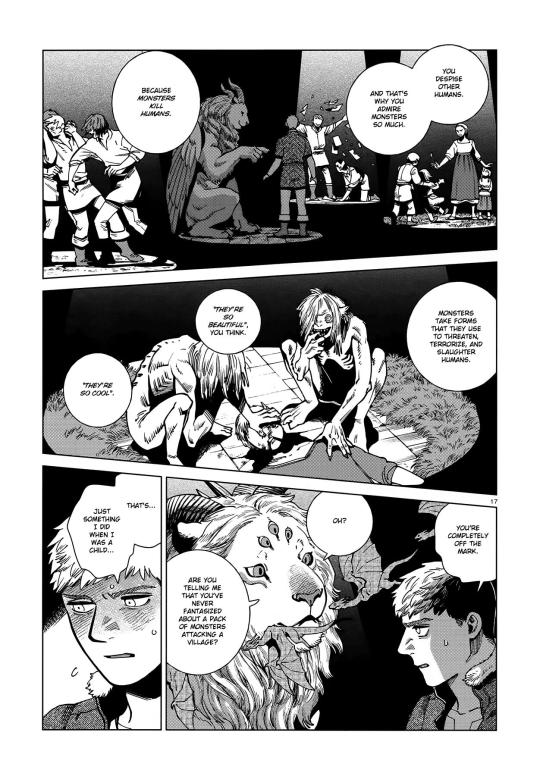
In response to how human society has othered him, Laios distances himself from humans and invests his time and energy into monsters and demi-humans instead. In the DunMeshi world, monsters and demi-humans are the ultimate societal Other. People fear them, exploit them, and even hunt and kill them. As someone who's similarly been mistreated by human society, Laios resonates deeply with monsters.
His desire to become a monster and/or beastman reflects his desire to reclaim agency over how society has ostracized him. If he chooses to become a monster, he gets to place value on what society has deemed despicable. He gets to choose why society hates him and be different on his own terms.
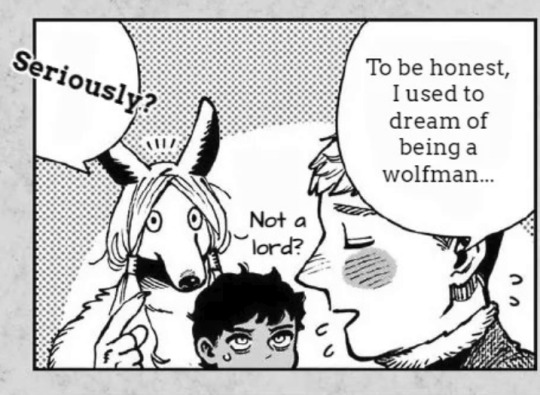
Both textually and thematically, Laios' identification with the Other bleeds into the erotic. More blatantly, he says that he'd have sex with orc women, and his succubus is a monstrous version of Marcille.


The entire story is also steeped in the theme of consumption as carnality. Laios and his party spend the entire manga eating monsters — a taboo physical act which they reap pleasure from; the underlying eroticism isn't difficult to see.
The story also presents consumption as a form of extreme identification. Eating a monster makes the monster part of you through digestion. The line between consuming the monster and becoming the monster — between erotic desire for the monster, demonstrated by eating their flesh, and identifying with the monster — is very blurred. Note that digesting a monster is an act of absorption; it destroys the original creature. Senshi states that consuming a monster erases "its individual identity," and major manga spoilers, but Laios defeats and pacifies the Demon by consuming its desire to eat. We'll come back to this concept later.
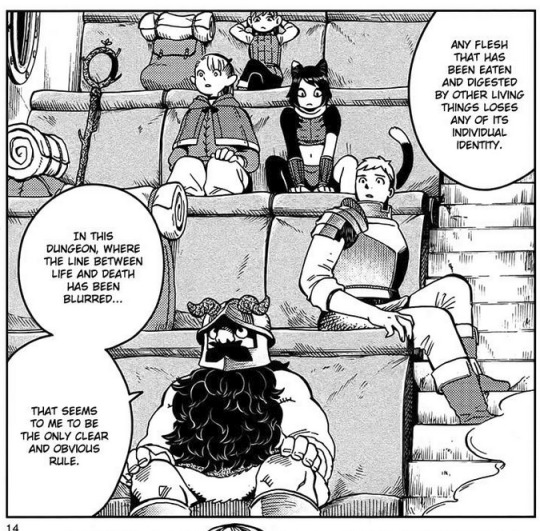
As previously mentioned, Laios is disinterested in most humans. The notable exception to this rule is Toshiro and by extension, the Eastern Archipelago. Laios doesn't seem to know much about the Archipelago before speaking to Toshiro, so he isn't drawn to Toshiro because he's an Easterner. Instead, he's drawn to his "odd appearance."

Just like Laios views monsters and demi-humans as a visible Other, Laios views Toshiro as another visible Other. On the Island, Toshiro stands out as a foreigner at first glance. While Laios as a white tallman doesn't appear visibly strange to other people, he's drawn again and again to people and creatures who are immediately visibly "odd." He sees them as understanding what it's like to be different and be mistreated for it, and since he relates to that experience, he wants to learn about them and be closer to them.
Essentially, Laios behaves towards Toshiro and his culture the same way he behaves towards monsters; he wants to know everything about Toshiro's foreign culture — the thing which makes him different. Unintentionally, Laios unintentionally reduces Toshiro to being Japanese; if he wasn't Japanese, Laios would never have approached him.
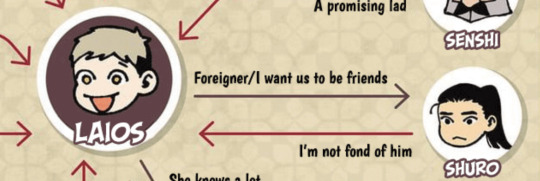
While Laios doesn't have bad intentions, as Toshiro himself acknowledges during their fight, his behavior towards Toshiro still has negative consequences. Laios' harmless interest in monsters translates to fetishization in the context of Japanese culture. He enacts multiple microaggressions against Toshiro and crossing his boundaries.
Laios goes beyond merely learning about Japanese culture. He takes parts of it for himself when he names his sword a Japanese name. Akin to his consumption of monsters, Laios attempts to participate in Toshiro's culture while failing to respect Toshiro himself. Just as eating monsters destroys them, Laios consuming Toshiro's culture while enacting racism against him causes real harm.
Many people have already written about Laios' microaggressions towards Toshiro, but a couple include Laios telling Toshiro that he looks "odd" and asking where he's from, mispronouncing his name as "Shuro," and assuming his favorite food is rice. Laios' treatment and fetishization of Toshiro is racist and harmful. However, I'd like to dive beyond the surface of Laios' micro-aggressive remarks and examine how his obsession with Toshiro becomes a racialized mode of desire, paralleling real world phenomena.
Though no concrete canonical evidence of Laios' feelings towards Toshiro being romantic and/or sexual exists, his interactions with Toshiro have erotic undertones. Their fight dialogue, in particular, revolves around eating, an act the story consistently shows as carnal. During this fight, Laios places his thumb in Toshiro's mouth and asks him, "What's the point of even having a mouth?" Laios' penetration of Toshiro's body via his mouth and his question's potential as an innuendo lend themselves to an erotic reading of the scene's more obvious conflict. Considering the overlap between consumption and carnality throughout the story, it's not a large jump to read eroticism into Laios demanding Toshiro meet his body's physical needs.


Furthermore, Laios is more enthusiastic about Toshiro than any other human in the series. While he cares deeply about his sister and his friends, Laios repeatedly expresses how much he admires Toshiro. He retains and brings up things like Toshiro's (perceived) favorite food. He wants to go to the East in Falin's place after she rejects Toshiro's marriage proposal, and in the "What-If" extra material, he's adamant about setting up a scenario where Toshiro travels with him through the Dungeon.

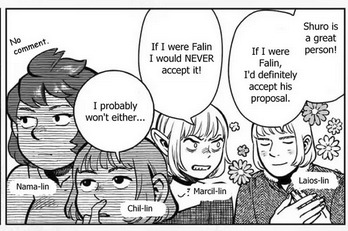

Undoubtedly, Laios is drawn to Toshiro. Since he sees non-white-ness and monstrosity as equivalent markers of societal othering, Toshiro's identity as a foreigner is what cultivates and maintains Laios' interest in him. Even if Laios learns to care for Toshiro as a person, his desire for Toshiro, platonically or otherwise, is still filtered heavily through race within the narrative.
Laios' relationship with his masculinity is also fraught. He broke off his engagement with a girl from his village and doesn't express normative interest in female tallmen. Seeing how the nightmare versions of his parents ask him when he's going to give them grandchildren, Laios experiences societal pressure to conform to a normative performance of masculinity through being attracted to and marrying a tallman woman and creating a family with her.
Laios frequently talks about how cool and admirable Toshiro is when he performs masculinity through combat, etc. He might find Toshiro's Asian masculinity more appealing and more accessible to him than the masculinity that's been forced onto him, precisely because Toshiro's Asian masculinity appears non-normative in a Western lens. But co-opting the masculinities of men of color as a white man would only further feed into the white consumption of cultures of color.
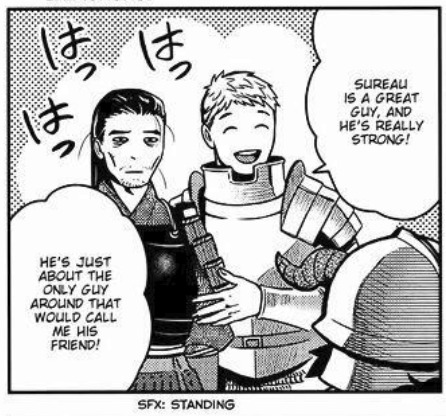
Overall, Laios' entitlement to and consumption of Toshiro's culture mirrors the real-life way white people co-opt and fetishize non-white cultures. Laios' fetishistic treatment of Japanese culture, because of his attraction (platonic or otherwise) to Toshiro, parallels white people's treatment of Asian people in the Western diaspora. I can only speak on the Asian American experience, but Laios immediately being drawn to Toshiro's "odd appearance," obsessing over his culture, and primarily treating Toshiro as a conduit for his said culture feels eerily close to how some white anime and/or K-pop fans act towards Japanese and Korean people.
Similarly to Laios, real queer, neurodivergent, and/or otherwise non-normative white people are marginalized by white Western society. They relate to how society others non-white cultures and/or people of color and latch onto them. While forming human connections based on curiosity and shared experiences is wonderful, white people are often unaware of the racial dynamics at play when they engage with non-white cultures and people of color and unintentionally, end up consuming and fetishizing non-white cultures in detrimental ways.
None of this negates the reality that Laios and Toshiro canonically care for each other. For instance, Toshiro's willingness to hug Laios reveals his genuine familiarity with and affection for him. The racial dynamics of their friendship complicate their relationship in fascinating ways and open up a potential path for Laios' growth. With time and effort, Laios could absolutely unlearn his racism and become a much better friend to Toshiro.
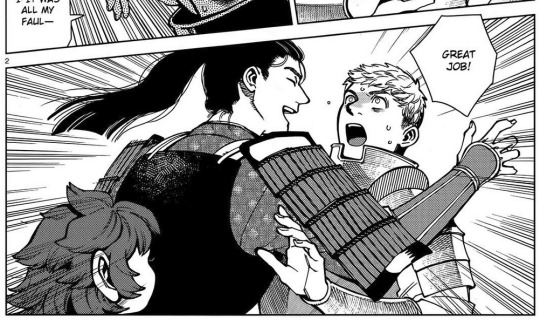
In conclusion, Laios' behavior towards Toshiro is a study in a marginalized white person's identification with and racialized desire for a non-white Other and how even a well-intentioned attempt at connection can replicate harmful racist dynamics. Toshiro's experience with Laios closely parallels real Asian people's struggles with racism and fetishization in our world today.
#laios touden#toshiro nakamoto#shuro#dungeon meshi#dunmeshi meta#dunmeshi analysis#i didn't want this to be superrr long but laios' treatment of the orcs is similar to his treatment of toshiro#he takes their cultural practices out of context and appropriates them (i.e. him wearing spoils of war when he declares himself king)#frankly him wanting to be an orc/wanting to sleep w orc women/appropriating their culture#and blurring the lines between identification/desire/consumption is even more clear than w toshiro#ryoko kui has a lot of interesting racial commentary in her work#but also she kinda flops on her depictions of black and brown ppl#anyw all very interesting to examine#i love u themes of consumption and desire and identity and borderline cannibalism#dunmeshi#delicious in dungeon#*mine#*meta
327 notes
·
View notes
Text
not even side eyeing anymore, it's just a full on head turn glare toward the people sidelining jimmy being a rapist and the SA of anya in favor of ooo toxic yaoiiii
#mouthwashing#actively yanking my hair out#anya mouthwashing#anyway anya ily you deserved better in everyway possible#swansea and daisuke too. love those guys#jimmy is a very interesting character dont get me wrong#would love to see long analysis posts unpacking him#but just like#man
179 notes
·
View notes
Note
you are so whimsical i qant to check out this mdzs (..??) because of your whimsical nature thank you sorry im very high and your art moved me emotionally
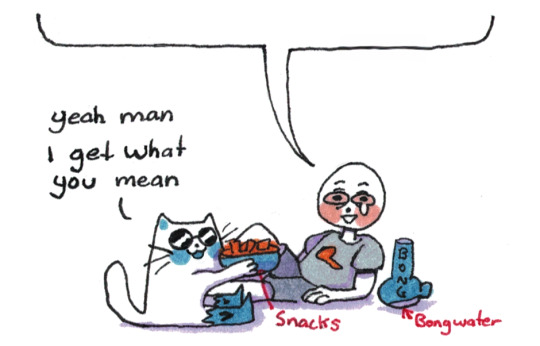
This is simultaneously the sweetest and funniest thing someone has sent me, thank you.
#ask#non-mdzs#I have a hunch you will not recall sending this to me but I wish to immortalize it.#The progression of me going 'aw' to 'barking with laughter' at the last bit of this message was a delight.#Oh man what to say about getting into MDZS...#I admit I'm probably low on the list of people who should be recommending it.#I enjoy it! But there are also a ton of different adaptations that each do a slightly different thing with the story and characters.#Personally I loved The Untamed (Netflix live action) for how campy the action was. It got emotional but really...It made me laugh.#And I love watching it with people because it also makes them laugh.#(The Untamed changes a lot of plot elements so it isn't looked upon very favourably by many fans. I love it as its own thing)#Don't get me wrong; it *is* a story with interesting things to say and I certainly have written tons of analysis on it.#But it's also a series I spent over a year making parody comics of. It comes from a place of love!#The audio drama is really good and I think it might be the best form of mdzs...however finding episodes is not easy.#The audio drama is also what I'm basing all these comics on!#There is a book (the primary source) An animated series and a comic to check out as well.#Someone probably has a better pitch and recommendation list than I do. I just make the funny comics.
349 notes
·
View notes
Text
I love how Michael becomes closer to Tori through the things she loves unlike Lucas who only pushes her away.
Lucas and Michael both bought Tori’s favourite drink for her, but only Michael got it right.
Lucas played Star Wars music during school assembly, whereas Michael went to watch the latest movie with her.
When Charlie got injured by Ben, Lucas organized that horrific event at the party, but Michael emotionally supported her.
Lucas locked Tori in a room and showed her a video of a violinist playing, whereas Michael actually did a duet with her.
Lucas did things, but Michael did them right.
#i just found this very interesting#tori spring#michael holden#lucas ryan#solitaire alice oseman#solitaire#solitaire analysis#cynic.txt
662 notes
·
View notes
Note
*sigh* thoughts on Nintendo's botw/totk timeline shenanigans and tomfoolery?
tbh. my maybe-unpopular opinion is that the timeline is only important when a game's place on the timeline seriously informs the way their narrative progresses. the problem is that before botw we almost NEVER got games where it didn't matter. it matters for skyward sword because it's the beginning, and it matters for tp/ww/alttp (and their respective sequels) because the choices the hero of time makes explicitly inform the narrative of those games in one way or another. it matters which timeline we're in for those games because these cycles we're seeing are close enough to oot's cycle that they're still feeling the effects of his choices. botw, however, takes place at minimum 10 thousand years after oot, so its place on the timeline actually functionally means nothing. botw is completely divorced from the hero of time & his story, so what he does is a nonissue in the context of botw link and zelda's story. thus, which timeline botw happens in is a nonissue. honestly I kind of liked the idea that it happened in all of them. i think there's a cool idea of inevitability that can be played with there. but the point is that the timeline exists to enhance and fill in the lore of games that need it, and botw/totk don't really need it because the devs finally realized they could make a game without the hero of time in it.
#i really do have a love-hate relationship with this timeline#because it's FASCINATING lore. genuinely. and i think it carries over the themes of certain games REALLY well#but i also think it's indicative of a trend in loz's writing that has REALLY annoyed me for a long time#which is this intense need to cling to oot#and on a certain level i get it. that was your most successful game probably ever. and it was an AMAZING game.#and i think there's definitely some corporate profit maximization tied up in this too--oot was an insane commercial success therefore you'r#not allowed to make new games we need you to just remake oot forever and ever#and that really annoys me because it makes certain games feel disjointed at best and barely-coherent at worst.#i think the best zelda games on the market are the ones where the devs were allowed to really push what they were working with#oot. majora. botw. hell i'd even put minish cap in there#these are games that don't quite follow what was the standard zelda gameplay at their time of release. they were experimental in some way#whether that be with graphics or puzzle mechanics or open-world or the gameplay premise in its entirety. there's something NEW there#and because the devs of those games were given that level of freedom the gameplay really enforces the narrative. everything feels complete#and designed to work together. as opposed to gameplay that feels disjointed or fights against story beats. you know??#so I think that the willingness to allow botw and totk to exist independently from the timeline is good at the very least from a developmen#standpoint because it implies a willingness to. stop making shitty oot remakes and let developers do something interesting.#and yes i do very much fear that the next 20 years of zelda will be shitty BOTW remakes now#in which botw link appears and undergoes the most insane character assassination youve ever seen in your life#but im trying to be optimistic here. if botw/totk can exist outside the timeline then we may no longer be stuck in the remake death loop#and i'm taking eow as a good sign (so far) that we're out of the death loop!! because that game looks NOTHING like botw or oot.#fingers crossed!!#anyway sorry for the game dev rant but tldr timeline good except when it's bad#asks#zelda analysis
165 notes
·
View notes
Text
Been dwelling on this for a while now, but aro Kabru is soooooooo interesting to me
Like, he's this guy who's often called a lady killer and whatnot by his friends because of his charms, but his intentions behind those are entirely nonromantic, and he even seems to have a kind of clinical view on romance, at times.
When he smiles at people and winks, he's trying to come across as friendly and approachable, not flirty. Because he's deeply fascinated with people, but in a like, wants to study them under a microscope kind of way. His party jokes a lot about him being a hit with women, but we never see him attempt to actually romance anyone. It's his facade that he wants to use on just about everyone, because he wants to be liked so he can be close to people and be able to immerse himself in other people's lives.
A lot of people criticise him for the casual way he treats Rin, with romantic gestures, whilst his canon stance on her is that he sees her like a sister. To my knowledge, it's unclear if he knows she likes him, but this is Kabru, so it's not unreasonable to assume that he's deduced as much. And yet he kisses her just to stop her casting anyway. It's such a clinical procedure. Kabru sees it as the most efficient and safe way to stop her, so he goes for it. And yeah, they both look like monsters to each other, but he so casually kisses a girl he probably knows has romantic feelings for him who he views as just like a sister.
It's not a big deal to him because he doesn't feel that way about her. Maybe won't feel that way at all. His perspective on romance is consistently like looking through a window, just studying other people's views on it, because it doesn't mean much to him.
When he edits Mithrun's backstory for Laios, he cuts out lots of what he sees as complicated, both out of respect for preserving Mithrun's privacy, but also just to make it simple enough for Laios, who has so little interest in human matters or motivations, to understand. And he centres it on a tragic love story! He thinks that Mithrun's love for a woman, and his jealousy over his brother having her interest instead, is a good, simple core motive. Romance is just a plot device to simplify and explain Mithrun's past motivations. Romance to Kabru is just another facet of people to study, something that makes them do things, and something that paints a broader picture of them.
It's a pretty detached view. He's a very shippable guy for a lot of fans (and for a lot of characters in story too, haha) but he's also someone whose idea of romance is just another thing to be studied. He's guy who does a lot of romantic or flirty things, whilst seemingly having no interest in romance for himself at all!
He doesn't feel romantic attraction, but it fascinates him anyway
#i mean absolutely zero ship hate with that part about calling out his shippableness btw#I think Kabru is very aro but im also something of a kabumisu girly and qpr is sooooo interesting to me too#Maybe I'll have to write a post about that someday too#This is a very headcannony analysis#dungeon meshi#delicious in dungeon#dungeon meshi spoilers#dungeon meshi manga spoilers#kabru#kabru of utaya#kabru dungeon meshi#aromantic#whiskers rambles
177 notes
·
View notes
Text
i've been thinking over this aspect of his character for a while now and i think i have enough material to make a post about it, so...
> genderqueer mitsuba!!
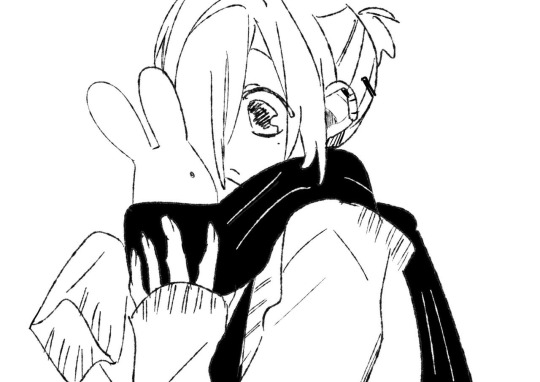
an analysis on mitsuba's peculiar gender expression and queercoding! ( ´∀ ` )
full post under the cut!!
before i begin, a disclaimer: mitsuba is canonically a boy, and i'm not trying to say he isn't!! he can be a boy and also genderqueer. genderqueer folks can still identify with the "binary" labels of girl or boy, since being genderqueer doesn't require anything aside from having a queer experience with gender. and as i'll explain in this post, his gender is pretty damn queer!!!
also for the record i myself am genderqueer. lesbian flavor
now, to start off: the immediately obvious.
it's pretty obvious that mitsuba is the most gender non-conforming character in the entire manga. from his medium length pink hair neatly tied up in a little ponytail, to more subtle details like his hands being drawn similarly to that of the female characters & his occasionally drawn bottom lashes, which no other male characters seem to have.


along with his general "you should not ask me to lift heavy objects" demeanor, all these more feminine details serve to make him distinct from all the other male characters in the manga, putting him in a kind of seperate category consisting solely of him.
and this idea of him being in his own seperate category ties in with other important aspects of his character as well!
for sousuke, it ties into how he was ostracized from his peers for standing out too much, and for no.3tsuba, it ties into how he feels alienated from humans & other supernaturals and feels as though he doesn't belong anywhere. if you think about it, it's all pretty analogous with the queer experience!

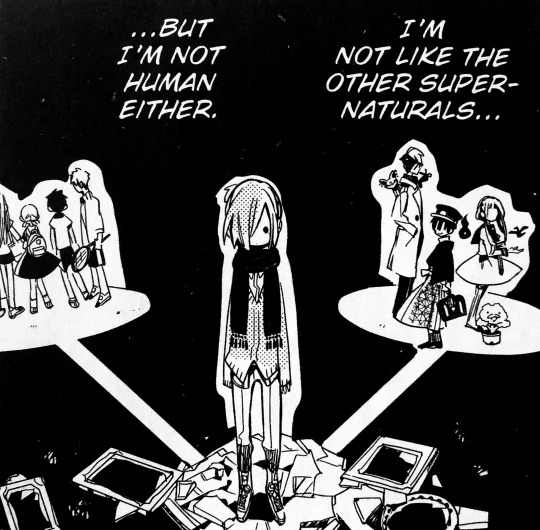
and going further with sousuke specifically, the turning point of his character arc was his conversation with kou on the stairs, where kou essentially tells him that he didn't have to try and fit into a polite box to make himself more likeable, and he can just express himself the way he wants to. ...i don't think i need to explain how this sentiment could easily be tied in with his queerness and gender expression lol


now i could go even deeper into how queercoded mitsuba's character arc is, but i think i'll leave it here for now.
another thing i wanna go over is the genderswap episode of the after school hanako-kun anime. now, the events of this episode including him didn't actually happen in the manga, so the canonicity is rather dubious. but i still think it's worth going over!!
this episode deviates from the manga by having mitsuba join hanako & sakura in the genderswap shenanigans. in the episode, mitsuba gets hit with the gender reassignment surgery beam and... well, basically nothing happens.

the joke here is obviously the fact he already looks like a girl, so you wouldn't really have to change anything in a genderswap, but the part i find the most interesting is how he himself didn't notice a change whatsoever.
i'm not sure how the specifics of the genderswap robot work, but i'd imagine he'd notice something was up, right? so to me, this scene just hammers in the fact that he's just kind of unnaffected by / outside of most things relating to gender. he's in his own gay little corner, he's immune to this shit!!
so in conclusion, mitsuba's gender is in fact very queered!! his queerness & gender expression is extremely interlinked with his character arc and motivations of feeling othered from the rest of the world, and i just felt like this needed to be discussed. and also i love him lots. <3

end of post!!! thank you for reading my autistic ramblings ^_^
#he is very interesting and special 2 me..#ocelotrambles#mitsuba#tbhk#mitsuba sousuke#jshk#tbhk analysis#jshk analysis#sousuke mitsuba#toilet bound hanako kun#tbhk mitsuba#jibaku shounen hanako kun
103 notes
·
View notes
Text
Thinking about how A!A lives in Cazadors castle, the place where he was tormented for 200 years, and the place where he killed over 7k people.
Thinking about how that place had no windows, had the paintings he hated.
Thinking about how down every turn cruel memories will torment him. He goes down a hallway and remembers Cazador dragging him down it. He goes in a room and remembers him and the other spawn beating eachother. He goes in the ball room and remembers preforming, and then watched as parties turned into slaughters.
He looks over contracts, writes letters, makes deals: literal paperwork. He talks to terrible people about doing terrible things. It's boring, tedious.
He would create new spawn to do his cores for him. Demand increasingly humiliating and bizarre things from them. Just to see what it would feel like. And it actually feels good, like some sort of justice. And to rationalize his treatment towards them he believes they are lesser creatures, they deserve it and they're nothing.
Something hurts him: a person, a knife, or fire whatever it is he has a crashing realization that hes not invincible. He rages, he killed 7k people, lives in this grimy castle that smells like death, his real friends hate him, and he hurts other people. And for what? What does he get for this?
An absolutely miserable existence.
#astarion#bg3#baulders gate 3#baldur's gate 3#angst#A!A#i dont hate A!A i find him very very interesting dont come at me#astarion headcanons#bg3 head cannon#character analysis
334 notes
·
View notes